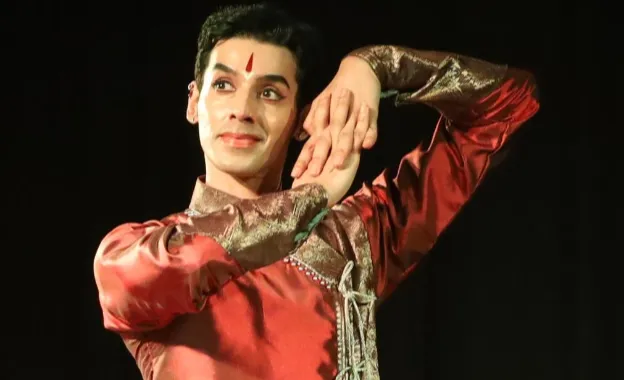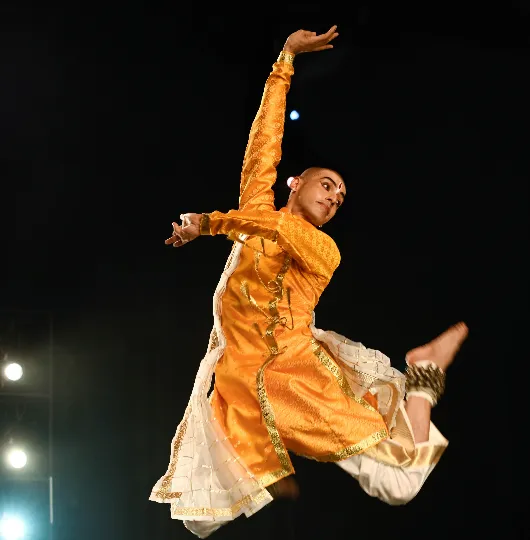Manesh Maharaj: preserving the legacy of Kathak in South Africa
A spiritual and artistic odyssey

Manesh Maharaj
Image: File
MANESH Maharaj, a Kathak dancer and artistic director of the Kala Darshan – Institute of Classical Music and Dance, has committed his life to nurturing this exquisite art form, while cultivating spiritual and creative growth among his students.
Born and raised in Kharwastan, Maharaj’s love affair with Indian classical dance and music began at age 7.
This, he said, ignited a lifelong passion that would see him not only leading but reshaping the landscape of Kathak.
Maharaj matriculated from Kharwastan Secondary School, followed by further studies at the Bharatiya Vidya Bhavan in Mumbai, where he earned a B.MUS degree in classical Hindustani music (sangeet visharad), specialising in sitar and vocal music.
Concurrently, he honed his dancing skills under the guidance of his late guru, Sushri Madhurita Sarang, under the Guru-Shishya Parampara system.
"I’ve always wanted to be a classical performing artist. It was a dream as far as I can remember," said Maharaj, recalling his formative years.
Maharaj's initial inspiration stemmed from his father, the late PT Thegram Maharaj, who not only encouraged him to engage in the performing arts but also instilled a sense of pride and purpose in his journey.

Performing a vibrant piece.
Image: Supplied
"When I entered high school, a sitar teacher from Mauritius came to teach in Durban. I trained in sitar under him for four years. He was instrumental in and encouraged me to further my studies in the Indian classical performing arts in India as there was no institute in South Africa that could train me further.
"As a child, I performed regularly for eisteddfods, music and dance festivals, shows and fundraisers. I was an all-rounder with singing, playing a variety of musical instruments as well as dancing. I have fond memories of dancing the role of Lord Krishna among a group of gopikas (milkmaids) for many performances. I actually still do now as a professional Kathakar."
He said as a classical artist, and while growing up, not much was accessible in terms of live performances apart from the rare footage of a visiting Kathak dancer from India.
So, he used to watch these performances on television on the programme Impressions.
"I used to video record these dance pieces and watch them over and over again and also try to mimic them. I eventually studied Kathak in Mumbai under the tutorship of Guru Sushri Madhurita Sarang at her institute, Nritya Darshan."
He was drawn to Kathak due to its dazzling pirouettes, vibrant rhythms and intricate footwork.
"Kathak is one of the eight classical dance forms of India and has its origins in the remote temples of Northern India. It journeyed into the opulent courts of the Mughal and Rajput courts and flourished as a dance form with a high degree of formalisation and stylisation.
"Apart from its dynamic rhythms and high energy, Kathak also incorporates in its repertoire deeply evocative and emotive pieces. It is the only dance form that presents a strong symbiosis between two unique religions, namely Hinduism and Islam, as they exist in harmony through art. For me this is the most beautiful aspect of Kathak and an ideal lesson for society."
He founded the Kala Darshan – Institute of Classical Music and Dance in 1999 with the aim to preserve, propagate and advance the standard of the Indian classical performing arts in South Africa as well as to enrich the cultural soil of the country.
"Kala Darshan specialises in pure classical Kathak only. My students range in age from 6 to 58. Under the banner of Kala Darshan, I have produced and directed more than 50 music and dance productions. Some of them are Krishnaleela, Taal Tarang, Bandish, Swarangika, Rasarang, Kathamrita, Ragas and Talas, Satvika, Sampradaya, Tridhara and Taal Chakra.
"One of the productions close to my heart is, Mahadevi – Visions of the Goddess. This was inspired by a hijacking I was involved in during which I had visions of the Goddess Durga. I truly believe that I survived that ordeal by the grace of the Goddess. I became a great devotee thereafter and produced, Mahadevi as an offering to the Divine Mother."
Maharaj also collaborated on a regular basis with the Durban-based Flatfoot Dance Company. Three of the memorable productions with them were Sadhana and Migrations – At the feet of Kali and Bhakti. He said he appreciated that the director and choreographer, LLianne Loots, seamlessly merged Kathak and African-contemporary dance while retaining the authenticity of Kathak.
Having performed extensively in South Africa as well as Zambia, Reunion Island, Senegal, India, Germany and Switzerland, Maharaj said he was currently working with his Kathak ensemble towards a festive season production titled Umang – The joy of Kathak which would be presented by The Playhouse Company on December 12 and 13.
"The production is a full-length Kathak showcase highlighting the joy and vibrance of Kathak with specially curated pieces in praise of love, unity and harmony. The ensemble comprises seven dancers, including myself."
Maharaj said he considered himself "truly fortunate" as being a Kathak dancer had never been a challenge for him.
"On the contrary, it has been a divine blessing, steering me towards the path of spirituality and self-realisation. If done correctly under the expert guidance of a guru, Indian classical dance forms not only heal the body but equip the dancer with mental and spiritual endurance. If Kathak is taking a toll on the body, then it is being practiced incorrectly."
He added that many boys learnt Kathak in India, and that it was originally performed only by male dancers who were Goud Brahmins from priestly families.
"The cosmic dancer himself, Lord Nataraja, is male. Personally, I was never poked fun of or ridiculed for learning dance. I feel fortunate and blessed in that sense as I’ve met many young promising male students who face backlash for wanting to pursue dance, especially Indian classical dance. I can only attribute this to ignorance.
"I recognise it as my karmic duty to preserve and spread the art of Kathak, especially in South Africa. It is my love, my work and my devotion. Kathak is not just a dance style. It is a sacred calling and whoever is ready to embrace the path of spirituality and awakening will be drawn to the grace of its timeless tradition.
"In light of this, training in Kathak may not appeal to everyone. A certain level of spiritual consciousness is essential. I have students from various generations learning at Kala Darshan who are inspired by our performances and who want to continue reaching new heights in their Kathak journey. If you are a seeker of divinity, Kathak is the ideal medium to fast-track your journey."
Asked if he specialised in other Indian classical dance forms, his response: "I only specialise in Kathak and believe that even an entire lifetime is too short to fully explore this great art-form."